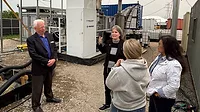Abandoned Oil Wells in West Texas Come Back to Life
Some suspect fracking wastewater disposal could be contributing to the pressure pushing water up through abandoned wells

Photo by K. Mitch Hodge on Unsplash
Abandoned oil wells across the United States are posing significant environmental and health risks, from gushing water and toxic gas releases to undermining carbon capture efforts. Inside Climate News has extensively investigated this issue, highlighting the challenges of addressing the thousands of such wells scattered across the country.
In West Texas, ranchers like Schuyler Wight have noticed a growing number of abandoned wells coming back to life, with gassy water gushing onto their land.
"It's getting worse, there's no question about that," Wight told Inside Climate News. These mysterious water bursts have sparked concerns and questions about what's driving the phenomenon, with experts suspecting the injection of fracking wastewater as a potential cause.
The Permian Basin has seen an increase in fracking wastewater disposal in recent years. Oil producers pump millions of gallons of so-called produced water, laced with chemical lubricants and hazardous compounds, underground every day for disposal, often into old oil and gas wells. Some suspect this could be contributing to the pressure pushing water up through abandoned wells.
"There's been such an increase in disposal of produced water over the past decade, there's an overwhelming amount of water being disposed," said Dominic DiGiulio, an environmental consultant and geoscientist who worked for 30 years at the EPA. "That pressure has to go somewhere. So if there's a well penetration then it's going to move freely up that well penetration."
The salt in the water poses a particular problem for ranchers like Wight. "The salt poisons the ground and nothing will grow after that," he said.
The risks from abandoned wells extend beyond water. Inside Climate News has reported on the release of cancer-causing benzene and other toxic gases from sites in Pennsylvania, raising concerns about the millions of other abandoned wells across the country. In California, public health battles have emerged over idle wells, many of which have been abandoned for over a decade.
Abandoned wells also pose a threat to efforts to combat climate change. In Louisiana, a new report highlighted the risk that 120,000 abandoned oil and gas wells pose to carbon dioxide storage, a key carbon capture and storage strategy.
The issue of abandoned wells underscores the need for stronger regulation and more resources to plug and remediate these sites. As Inside Climate News has reported, state oil and gas regulators face significant challenges in locating and plugging the thousands of wells across Texas alone.
The problem of abandoned oil wells is a nationwide issue, with environmental and health impacts that will only continue to grow without concerted action.
Looking for a reprint of this article?
From high-res PDFs to custom plaques, order your copy today!






